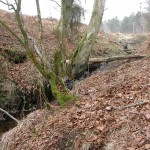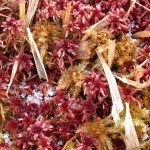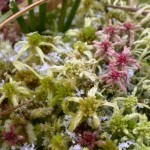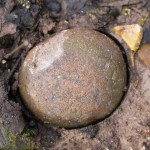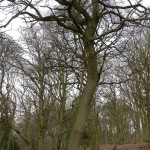Lesley Dunlop led a geology walk at Snelsmore Common, north of Newbury, on Saturday 23rd February. The temperature was just below freezing and snow was falling gently as 14 members set out from the car park. The walk started on gravel, laid down about 450,000 years ago by outwash from ice sheets to the north. Gravel deposits of the same age are found over a wide area, including on the tops of Greenham and Bucklebury Commons. The vegetation on the gravel was predominantly heather and birch. Heading southwards along the eastern side of the common, the ground became wet underfoot as the track dropped down slightly onto London Clay. The mire to the west of the path was cushioned with pillows of sphagnum moss, including the red Sphagnum capillifolium and the yellowish-green S. palustre. The London Clay was deposited about 50 million years ago. The gradient increased sharply and the mire turned into a stream in a deep gulley as the track crossed onto the Lambeth Formation (formerly known as the Reading Beds) of sands and clays, laid down about 60 million years ago. The sandy beds were marked by birch, honeysuckle and bracken, and there were Hard Ferns growing in the shaded stream bank.
The route then continued back up onto the gravels at the top of the central ridge of the common. Most of the stones of the gravel were angular flint, but there were also some rounded pebbles, which must have been on a beach at some point in their history. Gorse was in flower and three Exmoor ponies were grazing amongst the heather. Another track led steeply down to the western boundary ditch and fence. The fields below marked the transition onto the chalk, laid down about 85 million years ago. The bright green of the grass was in marked contrast to the dull browns of the vegetation on the common. Continuing northwards along the boundary, on the lowest sandy layer of the Reading Beds, a series of circular depressions on the right of the path marked a line of swallow holes, where acid water from the common had dissolved the underlying chalk. Some of the trees on the sides of the swallow holes sloped inwards, indicating that the holes had continued to develop after the trees had started to grow. Some of the bigger trees had a series of curves in their trunks, indicating that they had bent back to the vertical, and then been tilted again by continued growth of the hole. On the walk back to the car park, a Sparrowhawk was spotted, flying low above the ground along the edge of the trees.

